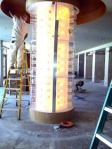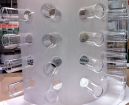 Polycarbonate (“PC”) is a remarkable plastic for a variety of uses including greenhouses and awnings. With Spring comes cleaning including our glazing plastics like polycarbonate or acrylic. Eventually you will need to clean the material to restore its lustre. At this point unfortunately people are unaware of the sensitivities of polycarbonate and may damage the material. There are two key areas you need to watch out for:
Polycarbonate (“PC”) is a remarkable plastic for a variety of uses including greenhouses and awnings. With Spring comes cleaning including our glazing plastics like polycarbonate or acrylic. Eventually you will need to clean the material to restore its lustre. At this point unfortunately people are unaware of the sensitivities of polycarbonate and may damage the material. There are two key areas you need to watch out for:
Scratching:
Natural polycarbonate is not scratch-resistant. It might be difficult to understand but the same material that can take extreme impact from hammers and bats (just check YouTube) without breaking cannot resist simple scratches. When cleaning PC you need to be aware of this and prepare accordingly. The big mistake here is using a sponge or other cleaning brush that can trap small particles like sand. Polycarbonate will scratch, so only use a clean (preferably new) cloth.
Solvents:
Polycarbonate is damaged by some common household solvents including Lysol, Pinesol and Isopropanol alcohol. In fact, you should avoid any of the stronger chemical based cleaning solutions to be safe. Certain lab experiments have shown that softer dish soaps like Palmolive or Joy are compatible with polycarbonate as is Windex. However, we cannot independently guarantee that and if you wish to use those solutions it is at your own risk.
So Then…How Do I Clean This Stuff?
Here is a recommended technique*:
1.) Rinse the polycarbonate
2.) Apply a mix of mild soap and warm water. Use a clean, new cloth made of soft material yet as lint-free as possible so it does not trap small particles that might scratch the polycarbonate.
3.) Do NOT wipe in a circular motion. Up and down uniform strokes only. This is especially important with multi-wall polycarbonate.
4.) Change the water and rinse the cloth often. If at any point you see particles then rinse immediately.
5.) Rinse, repeat until clean and make sure you dry with another soft cloth to avoid spots left by the water.
Polycarbonate is a useful material in many “diy” applications. A little care goes a long way!
If you need more information on our polycarbonate please contact us.
E-MAIL: sales@redwoodplastics.com
CDN: 1 800 667 0999
USA: 1 866 733 2684
*We recommend cleaning acrylic using the same method.

 We recently stumbled across a blog posting an application in a restaurant involving a giant wine rack
We recently stumbled across a blog posting an application in a restaurant involving a giant wine rack  that looks to be over 10 feet tall. The blog is short on details of the application, such as number of bottles held, however it does mention the different materials involved. Whereas most “diy” plastic projects involve commodity grade plastics (HDPE, LDPE, ABS) this application’s plastic materials are all engineering-grade.
that looks to be over 10 feet tall. The blog is short on details of the application, such as number of bottles held, however it does mention the different materials involved. Whereas most “diy” plastic projects involve commodity grade plastics (HDPE, LDPE, ABS) this application’s plastic materials are all engineering-grade.
